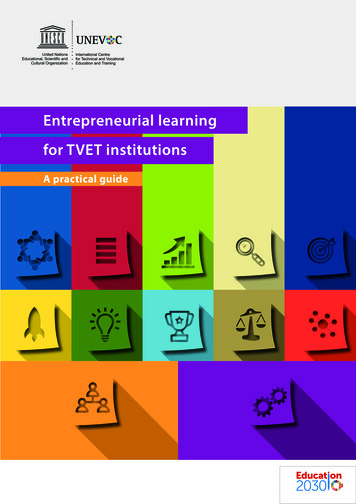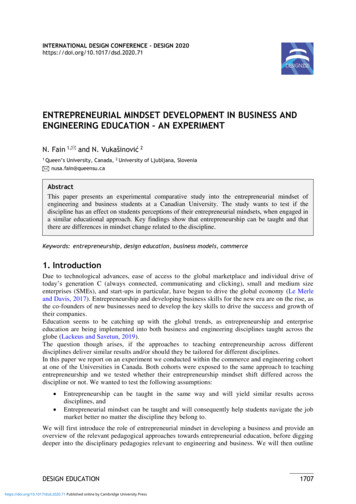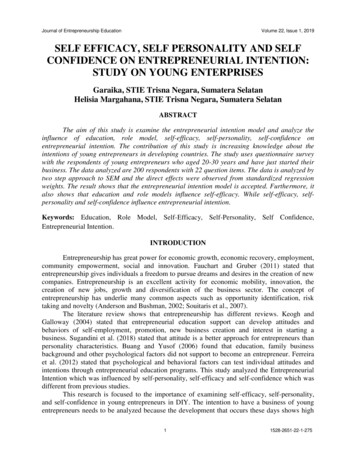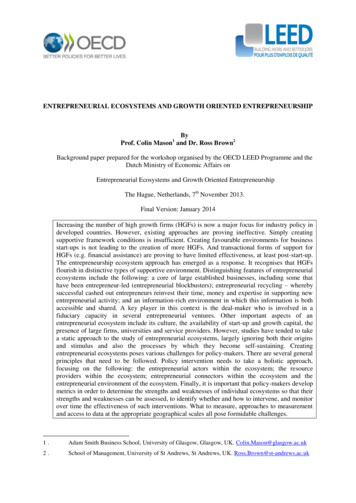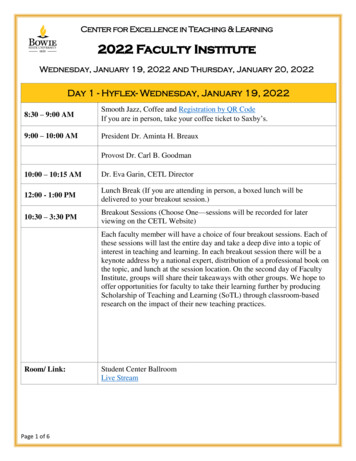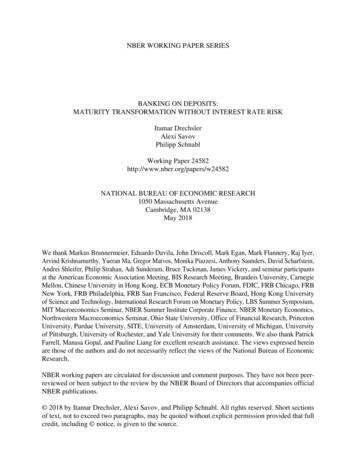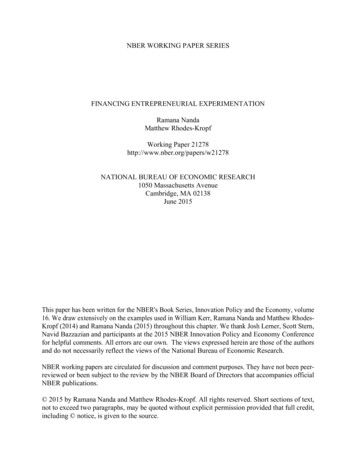
Transcription
NBER WORKING PAPER SERIESFINANCING ENTREPRENEURIAL EXPERIMENTATIONRamana NandaMatthew Rhodes-KropfWorking Paper 21278http://www.nber.org/papers/w21278NATIONAL BUREAU OF ECONOMIC RESEARCH1050 Massachusetts AvenueCambridge, MA 02138June 2015This paper has been written for the NBER's Book Series, Innovation Policy and the Economy, volume16. We draw extensively on the examples used in William Kerr, Ramana Nanda and Matthew RhodesKropf (2014) and Ramana Nanda (2015) throughout this chapter. We thank Josh Lerner, Scott Stern,Navid Bazzazian and participants at the 2015 NBER Innovation Policy and Economy Conferencefor helpful comments. All errors are our own. The views expressed herein are those of the authorsand do not necessarily reflect the views of the National Bureau of Economic Research.NBER working papers are circulated for discussion and comment purposes. They have not been peerreviewed or been subject to the review by the NBER Board of Directors that accompanies officialNBER publications. 2015 by Ramana Nanda and Matthew Rhodes-Kropf. All rights reserved. Short sections of text,not to exceed two paragraphs, may be quoted without explicit permission provided that full credit,including notice, is given to the source.
Financing Entrepreneurial ExperimentationRamana Nanda and Matthew Rhodes-KropfNBER Working Paper No. 21278June 2015, Revised October 2015JEL No. G24,L26,O31ABSTRACTThe fundamental uncertainty of new technologies at their earliest stages implies that it is virtuallyimpossible to know the true potential of a venture without learning about its viability through a sequenceof investments over time. We show how this process of experimentation can be particularly valuablein the context of entrepreneurship because most new ventures fail completely, and only a few becomeextremely successful. We also shed light on important costs to this process of experimentation, anddemonstrate how these can fundamentally alter both the rate and direction of startup innovation acrossindustries, regions and periods of time.Ramana NandaHarvard Business SchoolRock Center 317Soldiers FieldBoston, MA 02163and NBERrnanda@hbs.eduMatthew Rhodes-KropfHarvard Business SchoolRock Center 313Soldiers FieldBoston, MA 02163and NBERmrhodeskropf@hbs.edu
Financing Entrepreneurial ExperimentationI.IntroductionWhen it was founded in 1999, Google was in many ways a long-shot investment. Itsfounders were students, it was entering a space with many established competitors and hadno clear business model. In fact, more than one venture capitalist had turned down theopportunity to invest in Google at the time. One such firm was Bessemer Ventures, whosepartner David Cowan, on being asked to meet with the two Google founders working inthe garage, is believed to have quipped, “Students? A new search engine? . How can Iget out of this house without going anywhere near your garage?”Not everyone is as candid as about great deals they passed on as Bessemer Ventures,who have been so successful that they can playfully mock at their ‘anti-portfolio’ of investments.1 Nevertheless, the example of Google and of Bessemer Ventures frames a keychallenge for policy-makers engaged in entrepreneurship: although entrepreneurship iswidely acknowledged as being central to economic growth, the commercialization of themost promising ideas is not guaranteed, and depends critically on the ability of entrepreneurs to raise startup capital. The fundamental uncertainty of new technologies attheir earliest stages implies that it is virtually impossible for financiers to know the truepotential of a new venture. Often the only way to understand its potential is to learnabout its viability through a sequence of investments over time. Investors therefore playthe role of gatekeepers as they decide whether to make an initial investment to learn aboutthe viability of a radical new idea, how to interpret intermediate results, and whether tocontinue or abandon their investment. Costs or constraints to this experimentation cannot only impede entrepreneurship, but also fundamentally alter the trajectory of innovation in the economy by shaping which industries, regions, and time periods see the most1 seehttp://www.bvp.com/portfolio/antiportfolio
2MAY 2015radical innovations.In this paper, we synthesize recent research on the role of finance in entrepreneurialexperimentation. Our focus is on the financing of startups that commercialize new technologies. These startups form a small share of new firms each year, but are central tothe process of creative destruction through their role in creating new industries (such asautomobiles, semi-conductors, biotechnology or the internet) and the introduction of disruptive innovations in existing industries.2 For example, only about 1,000 of the 500,000new startups each year in the United States receive a first round of venture capital (VC)funding, but VC-backed firms account for about half of US IPOs each year. The processof experimentation across multiple rounds of financing is particularly valuable for suchventures because most fail completely, and only a few, such as Google, become extremelysuccessful (Robert E. Hall and Susan E. Woodward (2010)).Experimentation allows investors learn about a venture’s potential over time. Importantly, the ability to abandon investments at an intermediate point, before committingthe full amount of capital, allows investors to finance an initial exploration into an ideathat would not have been funded in an all-or-nothing bet. This is also good for entrepreneurs in that it allows more ideas to get an initial round of funding, but also implies thatmany projects are shut down early when intermediate information about their prospects ispoor. Viewed from the perspective of experimentation, failure is not necessarily bad if thebest projects are being selected and advanced. In fact, a large number of failed startupsmight even be an indication that investors are willing to finance extremely novel, radical,technologies. Nevertheless, a few thousand individuals working in a few hundred venturecapital firms are largely responsible for choosing and advancing the most radical innova2 This does not diminish the contribution of other startups to productivity growth in the economy. For example,the vast majority of startups do not commercialize new technologies, but a substantial share of productivity growthacross the economy is shown to arise from the birth of more productive firms and the closure of unproductive firmsrather than just through existing firms becoming more productive. Such firms (over 80% of which are in Construction, Retail and Wholesale Trade and Services) rely principally on their savings, personal loans or commercial creditto fund their operations and growth. Banks are the principal financiers for such ventures and are not the focus ofthis paper.
EXPERIMENTATION AND FINANCE3tions in the US economy, and it is easy to see how financing frictions may lead investorsto systematically overlook, or inefficiently shut down some extremely promising ventures.3Our paper provides a framework for understanding this process of experimentation and thesources of financing frictions. This naturally sets up the ways in which policies towardsthe financing of experimentation might help alleviate financing constraints for startupsengaged in innovation.The rest of the paper is structured as follows. In Section 2, we develop a simple framework that compares an all-or-nothing investment with one where the investor can experiment and abandon the investment at an intermediate stage, to provide an intuition forthe key results. Section 3 examines how the falling cost of an early experiment impactthe type of entrepreneurs who are backed, and sectors that see the most innovation. Weshow that investors naturally gravitate to sectors where the cost of experimentation islower, independent of the areas where there is the greatest need for innovation, or evenwhere the supply of innovative ideas are greatest. In Section 4, we consider how the ebbsand flows of capital interact with the financing of experimentation. We show how evenwhen the initial experiment goes well, shocks to the availability of capital can impact theability of a firm to finance its next stage. The fluxes in capital and investors’ beliefs aboutthe availability of capital at the next round of funding can have important implicationsfor whether investors are willing to finance an initial experiment at a given moment intime. For example, hot financial markets can amplify and even drive innovation in thereal economy, as these are instances in which investors are most likely to finance an initialexploration into a novel, new technology. Section 5 examines frictions associated withabandoning investments when intermediate information is negative. Investors may wantto build a reputation as being ‘entrepreneur friendly’, may face organizational resistancebecause investors have pet projects or may want to set a policy for being ‘failure tolerant’.3 For example, the National Venture Capital Association reports that there were 462 active venture capital firmsin the US in 2010 (Kerr, Nanda and Rhodes-Kropf (2014)).
4MAY 2015These factors have a bearing on what projects investors may start, and hence organizational and even institutional factors can drive the extent to which radical innovations arefunded in certain firms or certain regions. Section 6 concludes.II.Why is Experimentation Important?Startups engaged in innovation face fundamental uncertainty associated with theirprospects. A good example of the difficulty in determining how well a new venture willdo comes from Kerr, Nanda and Rhodes-Kropf (2014), who study internal data from asingle large and successful US venture capital firm. They look at ratings the partners atthis firm gave each deal at the time of first investment and study how this score relatesto the ultimate outcome of the same startups. They find that the correlation betweeninitial scores and ultimate performance of startups was 0.1, showing how even successfulprofessional investors have a hard time distinguishing among the most promising startupsat the earliest stages of investment. Using similar data from an angel investment group,Kerr, Lerner and Schoar (2014), find the correlation among the interest levels assignedto funded deals and their ultimate success was less than 0.1. More generally, that factthat the majority of venture capital investments fail (nearly 60% of this VC’s investmentsreturned less than the money invested) is itself indicative of the difficulty in predictingwhich firms will be successful and which will fail.In this environment of extreme uncertainty, experimentation allows investors and entrepreneurs to pursue projects that are not feasible in an all-or-nothing bet. A number ofpapers on venture capital have demonstrated that financiers of innovative firms want tostage their investments and learn more about the firm’s potential before investing further,in order to preserve the real-option to terminate their investment (see Paul Gompers,1995; Franchesca Cornelli and O. Yosha, 2003; Dirk Bergemann and Ulrich Hege, 2005;Z. Fluck, K Garrison and S. Myers, 2007; Dirk Bergemann, Ulrich Hege and Liang Peng,
EXPERIMENTATION AND FINANCE52008). In fact, it is standard for venture capitalists to negotiate control rights that allowthe investors to fire management and/or abandon the project (see Paul Gompers and JoshLerner (2004), William A. Sahlman (1990) and Thomas Hellmann (1998)). Even amongventure backed firms that are ‘successful’ Thomas Hellmann and Manju Puri (2002) andSteven Kaplan, Berk Sensoy and Per Stromberg (2009) show that many end up with CEOswho are different from the founders. To help demonstrate the key idea we set up a simplemodel which we then use as a framework for the remainder of the paper.PANEL A: ALL OR NOTHING BETSuccess: 1 Billion1%Investment: 11 M99%Fail: 0PANEL B: STAGED FINANCINGExperimentStage 2Intermediate ResultsPositive10%Invest 11 M10%Success: 1 Billion90%Fail: Value 0Fund theExperiment?90%Intermediate ResultsNegativeAbandon InvestmentFigure 1. Investor’s Decision TreeConsider a startup that requires 11 million to commercialize, will be worth 0 with 99%probability, and will be worth 1 billion (V) with 1% probability. This project will notbe pursued as its expected value is negative ( 1M ), i.e., 11M 0.01 1B. But whatif the entrepreneurs can conduct an experiment that will reveal that the project eitherhas a 10% chance of working or a zero percent chance of working. Furthermore, assume
6MAY 2015this experiment will reveal the more promising news with a 10% probability. Thus, theunconditional probability of success, 1%, is the same whether or not the entrepreneursconduct the experiment. The decision tree of the investor is shown in figure 1.The question facing the investor is whether it is worthwhile to finance the initial experiment. Intuition might suggest that since running the experiment increases the amountthe investor has to pay, the experiment is not worth pursuing. However, the value in theexperiment arises because it may prevent the investor from spending 11 million at all.The experiment can thus be thought of as an investment that pays off 89 million with10% probability and pays off 0 with 90% probability (since the investor will not investthe 11 million if the the results of the experiment are not promising). In our example,the probability that initial information is positive is 10%, so that the expected value ofthe experiment is 10% * 89 million 8.9 million. Thus, as long as the experiment costsless than 8.9 million, it should be run.We see from this that even though the original investment of 11 million was not agood idea, an investment of up to 8.9 million followed by an investment of 11 millionif the experiment is successful is a good idea - it is positive expected value. Spending anadditional 8.9 million to learn about the viability of the project is more valuable thansimply directly spending 11 million. This is the power of experimentation.4The value of experimentation stems from two sources. The first is the cost of theexperiment. Intuitively, it is easy to see that experiments that are not expensive to runare more likely to be valuable. The second driver of the value of experimentation is theamount of information that the experiment generates. More discriminating experimentsgenerate more information and hence make it easier for an investor to decide whetherto abandon their investment or continue financing the next stage. In an extreme, anexperiment might demonstrate nothing. That is, the probability of earning 1 billion4 We emphasize that the value of experimentation is not driven by the specific numbers chosen in this example.The Appendix provides a formal model to show this.
EXPERIMENTATION AND FINANCE7is the same no matter the experiment’s outcome. Alternatively, the experiment mightprovide a great deal of information. In this case, the value of the startup conditional onintermediate success would be much larger than the value of the startup conditional onfailure. We can think, therefore, of the difference in the value of the startup when theexperiment works and when it fails, as the amount or quality of the information revealedby the experiment. This difference is larger if the experiment reveals more about whatmight happen in the future. Overall, we see that experimentation is very valuable insituations when relatively small dollars invested can reveal information that results eitherin a valuable project going forward or preventing a mistaken investment.This simple example can be used to demonstrate the ideas that underlie recent work onentrepreneurial experimentation and finance and reveal the relevant policy implications.Given the need to experiment as a backdrop, we focus on three aspects of the financing ofexperimentation and the policies they imply. We will start with implications surroundingthe costs of experimentation. Then we will consider how experimentation interacts withvolatile financial markets and the risk a project will not be able to find financing inthe future even if the intermediate information is positive. Finally, we will examine thebenefits and costs surrounding investor tolerance toward early experimental failure whenintermediate information is negative.III.The Falling Costs of Experimentation and the Change in the Financing ofEntrepreneurshipThe above model makes the importance of the costs of experimentation very clear. If anearly experiment can be run cheaply and reveal enough information, then a startup can befinanced that otherwise could not. For example, technologies such as the internet, opensource software, cloud computing, etc., have reduced the costs associated with startinga new company. This shift has led to new ways to think about entrepreneurship, such
8MAY 2015as the Lean Startup methodology advocated by Steve Blank and popularized by EricRies (2011). The crux of Lean Startup Methodology is to identify and develop a “minimalviable products” (MVP). This experimental product seeks to validate as many assumptionsas possible about the viability of the final product before expending enormous effort andfinancial resources. The followers of this methodology frequently discuss how to make theirexperiments more cost effective, in large part so that they do not need to raise as muchmoney to pursue their ideas. As shown in the Appendix, a falling cost of experimentationis particularly valuable for startups that are “long shot bets”. These are startups startupswith low chances of initial success but where an investor can learn a significant amountfrom an initial experiment.The last two decades have seen dramatically lower costs associated with starting newfirms, particularly in industries that have benefited from the emergence of the Internet,open source software, and cloud computing. Industry observers suggest that initial experiments to learn about the viability of an idea in these sectors would have cost 5 milliona decade ago, but can be conducted for under 50,000 today. For example, Mark Andreessen, a prominent venture capital investor, notes that “In the 90s, if you wanted tobuild an Internet company, you needed to buy Sun servers, Cisco networking gear, Oracledatabases, and EMC storage systems. and those companies would charge you a ton ofmoney even just to get up and running. The new startups today, they don’t buy any ofthat stuff. They’re paying somewhere between 100x and 1000x [less] per unit of compute,per unit of storage, per unit of networking”. Andreessen also notes that the rise of servicessuch as Amazon’s Elastic Compute Cloud (EC2) have transformed many infrastructurecosts from upfront capital expenditures to subscription services that can scale with a company as it grows.5 Each of these features has made it significantly cheaper to finance aninitial exploration into the viability of a new idea. However, not all industries have been5 Douglas Macmillan, ‘Andreessen: Bubble Believers Don’t Know What They’re Talking About’, Wall StreetJournal, January 3, 2014.
EXPERIMENTATION AND FINANCE9equally affected by the technologies that have led to a fall in the cost of experimentation.In particular, the advent of Amazon’s elastic cloud compute services (EC2) lowered thecost of starting businesses in certain technology segments such as computer software andinternet business. However, biotech and medical device firms were logically less impactedby cloud computing.Michael Ewens, Ramana Nanda and Matthew Rhodes-Kropf (2015) use this idea andcompare new firms funded in the 2006-2010 period to those funded in the 2002-2005period across different industries. Consistent with the predictions of the model, they findinvestors are more likely to back unproven founding teams in the post period when thestartup is in an industry segment that benefited from Amazon’s EC2 services. In thesesectors, VCs backed younger founders and fewer serial entrepreneurs - these are startupsthat are likely to have a lower chance of success, but where the investor can now learna lot about the venture’s ‘traction’ with consumers without a large upfront investment.These results suggest that the falling cost of experimentation has helped to democratizeentry, particularly among young, unproven founding teams and has allowed for greaterexperimentation in certain sectors of the economy.Cheeper experimentation also allows more ‘audacious’ and costly projects to be completed. Going back to the example in Section 2, we saw that an 8.9 million experimentfollowed by an 11 million investment had a positive expected value, but if the requiredinvestment in the second stage was any more than 11 million then the project would notbe started. If the cost of the initial experiment dropped to say 5.5 million, this allowsa second stage investment that can cost as much as 45 million. Thus, a relatively smalldrop in the cost of the initial experiment (8.9 5.5 3.4) allows a relatively large increasein the cost of the project (45 11 34).An interesting example of this is the recent surge in the startups looking to commercializenuclear energy technologies. Recent advances have lowered the costs associated with
10MAY 2015simulating the inside of a nuclear reactor to learn about the viability of a potential newnuclear technology. This, in turn, makes it possible to finance an initial exploration ofradical new ideas in nuclear startups, despite the extremely large financial commitmentsrequired to build a nuclear reactor (e.g., it takes up to 4 billion to build a test reactor). Infact, Bill Gates, who made an investment to enable an initial exploration into the viabilityof nuclear startup Terrapower, specifically points to advances in supercomputing as thereason behind a resurgence in startups engaged in nuclear energy innovations in the lastfew years.The pace of technological progress therefore has a feedback effect on new innovations.Advances in supercomputers or cloud computing affect the cost of experimentation incompletely different sectors like nuclear energy and consumer internet and make viableprojects that could not have been started in the past. This helps sustain and potentiallyincrease high rates of technological progress.However, to the extent that risk capital is in short supply, the relative fall in the cost ofexperimentation can have important consequences for the composition of innovation thatis financed by the private sector. The majority of capital in professionally managed venturecapital firms comes from endowments, pension funds and sovereign wealth funds. Theseinstitutions tend to allocate capital to venture capital investors based on metrics that areoften unrelated to investment opportunities (Sampsa Samila and Olav Sorenson (2011)).Capital available to take experimental risks and fund new innovations is therefore limited,particularly in the short run. Thus, investors need to choose which, among many potentialprofitable ideas, they want to fund. A fall in the cost of experimentation in some areaswill increase the value of investing in those areas relative to others. Capital will then flowfrom areas with more costly experiments to those with less costly experiments. This willslow the innovation in the areas with less capital and possibly increase the shift in capitalto the area with ever cheeper experiments. This idea may provide an explanation for the
EXPERIMENTATION AND FINANCE11relative dearth of capital is some areas of our economy such as biotech and greentech wheretechnological advancement seems so important, while technologies related to mobile appsand social web seem to find abundant capital.The greater proportion of startups being financed by less expensive experiments alsoleads to changes in the type of financier that fund new ventures. When ventures requiremillions and even tens of millions of dollars to start they typically need to be backed byinvestors with large pools of capital. When the costs of experimentation plummet thereare a larger number of less expensive experiments that need to be run. This fall in thecost of experimentation should mean that investors with much smaller pools of capitalcan find viable investment opportunities. The last decade has seen a dramatic rise inangel networks, super-angel funds, accelerators and incubators as well as crowd funding.Furthermore, a new style of investing has risen that is colloquially referred to as ‘spray andpray’ in which investors take a very large number of small bets with limited due diligenceand hope that just one or two of these experiments turn out to be extremely successful.Each of these different types of investors and investing styles is the natural consequenceof the dramatic fall in the costs of starting a new high technology firm. In an economywith a plethora of very small start up experiments that need to be run, investors naturallyarise to support them. These ‘financial innovations’ help to maximize the impact of thetechnological shocks to the cost of experimentation.To summarize this section, we emphasize three points related to the cost of experimentation. First, differences across industries in the costs of experimentation and theability to learn from experimentation have a bearing on the degree of experimentationand radical innovation. For example, the very long time frames and costs associated withlearning about a new way to produce clean energy or different approaches to curing cancercreate a dearth of experimentation, despite intense societal interest (Jose-Maria Fernandez, Roger M. Stein and Andrew W. Lo, 2012; David E. Fagnan, Jose-Maria Fernandez,
12MAY 2015Andrew W. Lo and Roger M. Stein, 2013).Second, the pace of technological progress has a feedback effect on new innovations.As technological advances such as supercomputers or cloud computing diffuse, they havean effect on the cost of experimentation. The advances make viable projects that had anegative expected value in the past. However, the falling cost of experimentation will alsopull financiers towards the sectors where the returns from experimentation are greatest.Sectors where experiments are expensive or not as discriminating in the early stages of aventure are less attractive to investors and less likely to receive attention from financiers,independent of their importance for society or the amount of ideas that are available tobe commercialized.Third, financial markets will naturally respond to the fall in the costs of experimentation.New smaller investors and even individuals can more readily participate in a market withlow cost experiments. Note, however, that this market will be rife with failure. Manywill quickly conclude that this is because more junk is being funded by these smallerunsophisticated investors. However, more experimental projects should be expected tofail at a higher rate. Thus, failure rates alone will not reveal whether investors are makingmore investments or just investing in more radical projects. Instead we must wait to seethe extent to which new radical innovations that change how we live emerge from thiscacophony of experimentation. From the perspective of investors, it is important to notethat most investors in startup ventures will lose their investments entirely, while only afew will back startups that end up becoming big hits. This is even more likely to be truewhen the falling cost of experiments make ‘long shot bets’ viable for a first financing. Theprofile of returns from such investments looks very similar to a lottery, suggesting thattransparency into the likely outcomes of investments will be helpful for the larger set ofindividuals getting access to equity investments in private ventures through reforms suchas the JOBS Act - that aim to provide unaccredited individuals access to such investments.
EXPERIMENTATION AND FINANCEIV.13Financing RiskHaving examined how the direct cost of experimentation can impact the compositionof entrepreneurship and innovation, we turn next to challenges associated with the act ofstaged financing. We first look at a how staging investments can impose a challenge evenwhen intermediate information from the experiment is positive.Financing available for startups engaged in innovation is notoriously volatile (Gompers and Lerner, 2004; Steven Kaplan and Antoinette Schoar, 2005; Paul Gompers, AnnaKovner, Josh Lerner and David Scharfstein, 2008). Entrepreneurs and venture capitalinvestors constantly worry about these fluxes in capital and refer to them as financingrisk: the risk that the survival of an otherwise healthy startup might be threatened by anegative shock to the supply of capital in its sector when it is looking for the next roundof funding and hence derail its progress.6 This worry seems rational given the ebbs andflows of capital that have occurred within different venture sectors at different times.Ramana Nanda and Matthew Rhodes-Kropf (2014) explicitly model the response tofinancing risk by venture capital investors and provide a theoretical framework for whyinvestors’ response impacts the most novel technologies in the economy. They show thatinvestors can respond to financing risk by providing firms more upfront funding, hencemaking startups less vulnerable to the future state of the capital markets. The investorresponse can effectively eliminate financing risk, but it also comes at a cost: providingfirms greater upfront funding reduces investors’ ability to abandon their investment instartups if intermediate information on its prospects is poor. In fact, the value of the lostreal option can be high enough that it makes the investment unviable. They show how thistradeoff between wanting to protect firms from financing risk and wanting to preserve theoption to abandon the investmen
the investors to re management and/or abandon the project (see Paul Gompers and Josh Lerner (2004), William A. Sahlman (1990) and Thomas Hellmann (1998)). Even among venture backed rms that are 'successful' Thomas Hellmann and Manju Puri (2002) and Steven Kaplan, Berk Sensoy and Per Stromberg (2009) show that many end up with CEOs
